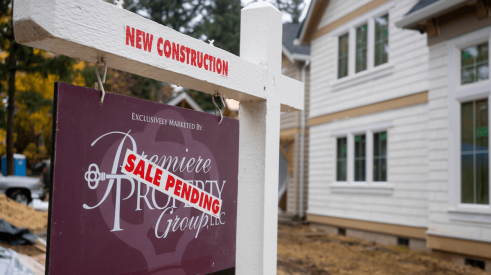Most builders know a stall when they see one. Sales have slowed and year-over-year comparisons show recent results and metrics are not in line with expectations. The question is what to do about it.
The most obvious action is to be introspective and determine if you recently changed something that could have caused the stall. Resolving a sales absorption issue is always a process of elimination mixed with an algebraic equation (meaning we need a constant in order to test our assumptions). The most important strategy to resolve the issue or issues is to make sure you test each assumption in a discrete fashion that allows enough time for the desired result to surface or prove you wrong.
So let’s begin the journey. But first, stay calm and don’t fire everyone in your line of sight. You have not determined the problem yet, so firing people could cause more problems and more delayed sales.
Finding the problem
I always begin by looking for the possible source or sources of problems. Typically, I work with my clients to outline the following potential problem areas and determine if they are inhibiting sales. The order is important and, in some instances, the lack of results may be driven by deficiencies across the operating platform.
Potential sources of problem by order of analysis
1. Political economy—Consumer confidence has dropped due to external factors:
- Politics
- Economics
- Mortgage rates
2. Public relations—Is there negative press or issues with your company or site?
3. Marketing—Are traffic numbers competitive or lower than those around you?
4. Sales results—Are sales conversion metrics at normal levels?
- Advertising in place?
- Website effective?
- Directional signage used consistently?
- Office schedule posted and adhered to?
- Sales agents trained properly?
- Community clean and orderly?
5. Community issues—Are amenities appropriate?
6. Competitive response—Did something change?
- New competitor with new product, price, place, people
- Competitive adjustments
7. Product specifications that may need to be revisited:
- Price
- Design
- Finishes
- Lot size
- Location
- Training of sales team
8. Operational performance:
- Cycle time is too long
- Quality of deliveries is low
- Warranty management not in place
- Missed closing dates
- Behavior of field or office staff with others is an issue
- Integrity of your company is a discussion point in the marketplace
9. Other—Always think out of the box and determine if there are any unique or exceptional events that could be influencing sales.
Any or all of the above could be factors contributing to stalled sales; the goal is to determine which is the most significant driver. The process of elimination is the sophisticated part of this analysis. It is important that you parse the data you have and determine the truth about your operating conditions as quickly as possible while your margin is suffering. Keep in mind if pricing is off or your value proposition is flawed, lowering prices does not automatically work. I will summarize each topic as cogently as possible. In practice, we may spend an entire day on any one of these topics, especially if we find weaknesses that are alarming relative to best practices.
Fixing the problem
Political economy: The political economy, which drives consumer confidence, is the obvious culprit if your business allies and the industry press all feel that a blanket of doom or an air of euphoria are in the sales offices. If research points to this, then all aspects of your deployment need to be running in excellent fashion as the market is either contracting or expanding. It is critical that you know and understand the relationship between mortgage rates and asset values, and do not overlook the slow creep of price appreciation and mortgage costs that can reduce affordability.
Public relations: Public relations and how your company and its locations are perceived by the public can be a bigger issue than you may think. In instances of market contraction, when fear is a major force for the consumer, they will run toward the least risk and the least negative companies and locations. If you have had issues with public relations and location image problems, you might want to invest in a public relations advisory firm’s expertise. If a problem exists, keep in mind it will take three-to-12 months to right what has gone sideways.
Marketing: Marketing drives awareness of your value proposition to the consumer. If your marketing efforts do not have clear tactics and goals, then you may be selling yourself short. Some companies have fragmented and less strategic approaches to branding and awareness building. Even communities in the best locations suffer if you do not have a method to drive traffic to your locations. Indicators of your marketing effectiveness will surface in survey cards filled out by customers in your models. Always analyze and understand the source of your traffic. Two key elements in driving traffic are your directional signs and your website. If you have concluded that the political economy and public relations are not the issue, then perhaps a problem with directional signs and/or your website are to blame.
Sales results: If your sales conversion ratios normally run at 7.5 percent and are now running at 5 percent, first look at the three issues discussed above. Nationwide conversion ratios have dropped in the past six months, but you may have a sales management issue. The exact weakness can be hard to determine, but a lack of confidence in the sales team may be the culprit. A good way to see if that is the problem is by putting a proven sales manager in the weakest community for at least 60 days. If numbers improve, you may have identified the problem.
Community issues: If you have community issues and you are not the developer, welcome to the conflict zone. When a developer is not doing his part of the deal—putting in the entrance sign, sidewalks, signage, pocket park, pool or walking trails, and various other amenities—you have grounds for a frank discussion. Remember, with the customer you have only one chance to make a good first impression. If your homes are 100 percent spot-on, but your community is a shambles (trash, weeds, unfinished signage, poor landscaping) you will lose the customer’s trust immediately, especially if the relative contrast with the competition is obvious.
Competitive response: An undetected competitive response or a new player in your market area can send you into a tailspin. Adding your own new product without the correct product and price differentiation can do the same thing to stall sales. Sometimes I do a quick two-to-three-day review of a market for clients to let them know how they may have lost their way. Many times, a sales team is unaware of the depth and breadth of competition that has come into their submarket. The solution is to hit the reset button, train and educate, and get back on track within three months or less. Bear in mind, markets shift in three-month cycles and I cannot emphasize enough the need to have a point person who is always checking and analyzing the market conditions in addition to your own efforts.
Product specifications: Your product itself may be wrong for your market and can cause significant harm to your desired sales rates. Market comps can help you create more accurate products, prices, designs, and finishes. Sometimes the easiest fix for this problem is product training for your salespeople. A little effort in this area may help them boost the sales closing ratios. Lot sizes also can be wrong for what the market is looking for. This is too complicated to discuss here but if you missed the lot-size sweet spot, you have an issue that needs a collaborative solution with the developer and the local jurisdiction.
Operational performance: Poor operational performance is an insidious and silent killer of sales. Why? Talk on the street, unhappy customers, failure to do what you say, and general poor behavior will kill your sales efforts. If your sales team complains that it takes too long to deliver your homes and that you missed promised close dates, you have more than a sales problem; you have an operations problem that is flowing over into your sales effort. I have seen plenty of these situations; it is best to get help immediately. Do not pass go, do not collect $200. And don’t allow sales and operations to fight it out, or you will wind up with both groups feeling very frustrated. As the company’s leader, you might need to jump in and lead and manage for a while. In this scenario, the integrity of your entire company is at risk and you need to invest in systems and processes pronto to get it back on track.
Fun vs. nightmare
Home building is a lot of fun when it is running well, and a nightmare when it is not. We all spend our days at some point along the fun-to-nightmare continuum. If you are closer to a nightmare, understand your customers are right there with you and, as a result, your sales will slow. Do not succumb to the idea that everything is price sensitive and that by lowering the price you will solve your problem. You may in the short term boost sales, but in the medium and long term you must come to understand why the value proposition was not in alignment with the customers’ view of value.
There may be other causes for a stall in your absorption rates, but the majority of them will emerge from the list I have outlined above. I hope this discussion has broadened your approach on how to problem-solve, and from it you can analyze and determine why you have slow sales. Keep in mind, the reasons vary and the effects of seasonality should always be considered. The basic rule of happiness for sales is this: If the value proposition matches the price in the customer’s head, you will make sales. If it does not, you will not sell as much as you expected. A sales stall is the last thing you need in this market, so make your price changes in a thoughtful way and keep the production train on track. PB
Noelle Tarabulski is CEO of Builder Consulting Group in Lakewood, Colo., a management consulting firm dedicated to builders and developers since 1991. She can be reached at noellet@buildertools.com.









